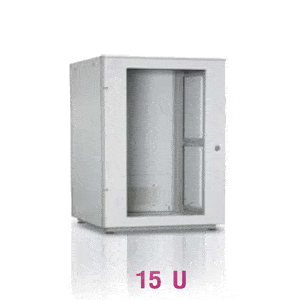ทำความรู้จักกับ ตู้แร็ค
ตู้แร็คหรือ “Rack” ในคอมพิวเตอร์และเทคโนโลยีสารสนเทศคือโครงสร้างหรือตัวเฟรมเวิร์กที่ใช้ในการจัดเรียงและติดตั้งอุปกรณ์อิเล็กทรอนิกส์แบบแน่นๆ ที่สำคัญสำหรับการให้บริการและบริหารจัดการเครือข่ายและระบบคอมพิวเตอร์ในองค์กรหรือศูนย์ข้อมูล ตู้แร็คมักถูกใช้ในสภาพแวดล้อมที่ต้องการการจัดระเบียบและการรักษาความเรียบร้อยของอุปกรณ์เน็ตเวิร์ก เซิร์ฟเวอร์ สายสื่อสาร และอุปกรณ์เครื่องมืออื่นๆ ที่เกี่ยวข้องกับเครือข่ายคอมพิวเตอร์
นี่คือบางคุณสมบัติและข้อมูลสำคัญเกี่ยวกับตู้แร็ค:
- ขนาดและมิติ: ตู้แร็คมีขนาดและมิติที่คงที่ตายตัว เพื่อให้ง่ายต่อการติดตั้งในพื้นที่ที่มีพื้นที่จำกัด ขนาดมาตรฐานของตู้แร็คในหน่วย “ยู” (U) ซึ่งมีความสูงประมาณ 1.75 นิ้ว (4.45 เซนติเมตร) แต่ตัวตู้แร็คสามารถมีความสูงต่างๆ ได้ตามความต้องการของอุปกรณ์.
- การระบายความร้อน: ตู้แร็คมักมีระบบระบายความร้อนเพื่อรักษาอุปกรณ์ที่อยู่ข้างในในสภาวะอุณหภูมิที่เหมาะสม ส่วนใหญ่จะมีพระเก็งลมและพระเก็งความชื้นเพื่อควบคุมสภาพแวดล้อมภายใน.
- การจัดเรียง: ตู้แร็คมีช่องว่างหลายชั้นที่ใช้ในการจัดเรียงและติดตั้งอุปกรณ์ เช่น เซิร์ฟเวอร์ สวิตช์ รูเตอร์ และอุปกรณ์เครื่องมืออื่นๆ โดยใช้แผงลายพิเศษที่เรียกว่า “แร็คมาว์ท” (rack-mount) เพื่อให้อุปกรณ์ต่างๆ สามารถติดตั้งลงในตู้แร็คได้อย่างเรียบร้อยและปลอดภัย.
- การจัดสาย: ตู้แร็คมีระบบการจัดสายที่ช่วยให้การเชื่อมต่อและการเดินสายเคเบิลออกแบบให้เรียบร้อยและสะดวกต่อการบริหารจัดการ.
- การรักษาความปลอดภัย: ตู้แร็คมักมีระบบรักษาความปลอดภัยเพื่อป้องกันการเข้าถึงไม่ชอบด้วยรหัสผ่านหรือระบบการตรวจจับการเข้าถึง.
- การจัดการพลานต์: บางตู้แร็คมาพร้อมกับระบบจัดการพลานต์ที่ช่วยในการควบคุมและดูแลอุปกรณ์ในตู้แร็ค รวมถึงการสำรองข้อมูลและการตรวจสอบสถานะของอุปกรณ์.
- ความยืดหยุ่น: ตู้แร็คมักมีการออกแบบให้เป็นแบบยืดหยุ่นเพื่อให้สามารถเพิ่มหรือเปลี่ยนแปลงอุปกรณ์ได้ง่ายๆ เมื่อความต้องการเพิ่มขึ้น.
- การเชื่อมต่อ: ตู้แร็คมีช่องต่อเชื่อมต่อสำหรับเครื่องมือเข้าระบบไฟฟ้าและเครือข่าย เพื่อให้อุปกรณ์สามารถทำงานร่วมกันในระบบเครือข่ายหรืออินเทอร์เน็ต.
การใช้งานตู้แร็คมากขึ้นเป็นสิ่งที่สำคัญในศูนย์ข้อมูล ศูนย์ข้อมูลคือสถานที่ที่ต้องการการรักษาความมั่นคงและปลอดภัยของข้อมูลและอุปกรณ์คอมพิวเตอร์ เช่น เว็บโฮสติ้ง ศูนย์ข้อมูลองค์กร หรือศูนย์ข้อมูลระดับอาณานิคม ตู้แร็คเป็นส่วนสำคัญในการสร้างพื้นที่ที่เป็นระเบียบและมีประสิทธิภาพสำหรับการทำงานของระบบเครือข่ายและคอมพิวเตอร์ที่ใช้ในศูนย์ข้อมูลเหล่านี้.

Certainly! A “rack” in the context of computers and information technology refers to a framework or network structure used to organize and install electronic equipment densely. It is crucial for managing and administering computer networks and systems in organizations or data centers. Racks are typically used in environments where equipment needs to be organized and kept neat, such as networking gear, servers, communication cables, and other related electronic devices.
Here are some key features and information about racks:
- Size and Dimensions: Racks have standardized sizes and dimensions, making them easy to install in space-constrained areas. The standard size unit for racks is called “U” (for “rack units”), with a height of approximately 1.75 inches (4.45 centimeters). However, rack heights can vary based on equipment requirements.
- Heat Dissipation: Racks often come with cooling systems to maintain the appropriate temperature inside, ensuring that the equipment functions optimally. These systems may include fans and humidity control mechanisms to regulate the internal environment.
- Organization: Racks have multiple shelves or slots for organizing and mounting equipment such as servers, switches, routers, and other tools using rack-mount panels. This allows equipment to be neatly and securely installed within the rack.
- Cable Management: Racks typically include cable management systems to facilitate neat cable connections and routing.
- Security: Racks may have security measures in place to prevent unauthorized access, such as password protection or access monitoring.
- Power Management: Some racks come with power management systems that assist in controlling and monitoring the equipment within the rack, including data backup and equipment status checks.
- Flexibility: Racks are often designed to be flexible, allowing for easy additions or changes to the equipment as needed.
- Connectivity: Racks feature connectors for electrical and network connections, enabling equipment to work together within a network or the internet.
The use of racks has become increasingly important in data centers, where maintaining the security and reliability of data and computer equipment is crucial. Data centers are facilities dedicated to storing and managing large amounts of data and computer systems, and racks play a significant role in creating an organized and efficient space for networking and computer equipment in such environments. https://rackwell.com/%e0%b8%97%e0%b8%b3%e0%b8%84%e0%b8%a7%e0%b8%b2%e0%b8%a1%e0%b8%a3%e0%b8%b9%e0%b9%89%e0%b8%88%e0%b8%b1%e0%b8%81%e0%b8%81%e0%b8%b1%e0%b8%9a-%e0%b8%95%e0%b8%b9%e0%b9%89%e0%b9%81%e0%b8%a3%e0%b9%87%e0%b8%84/
